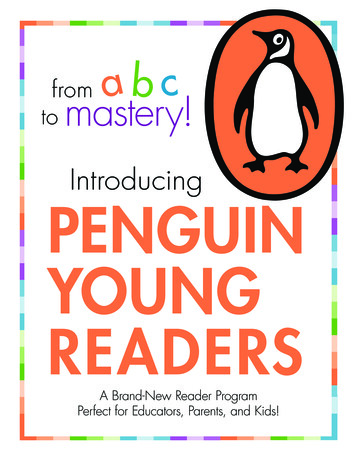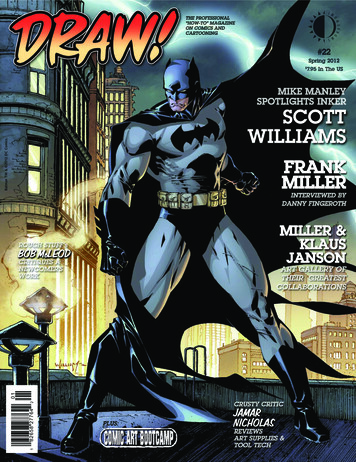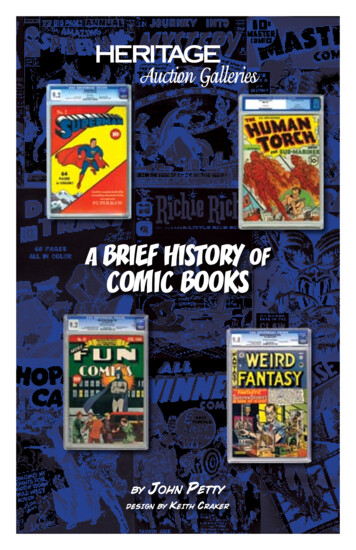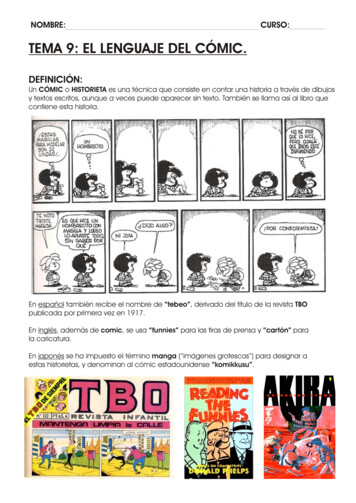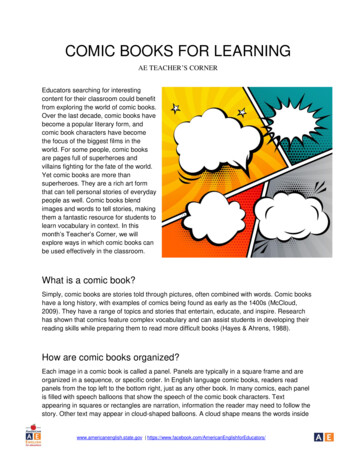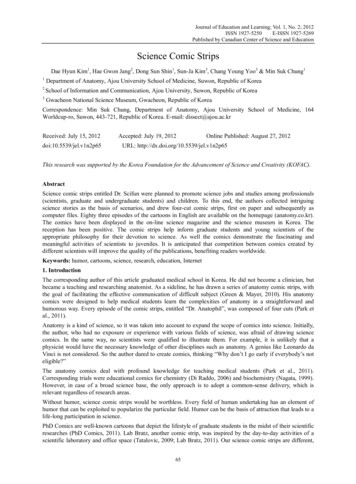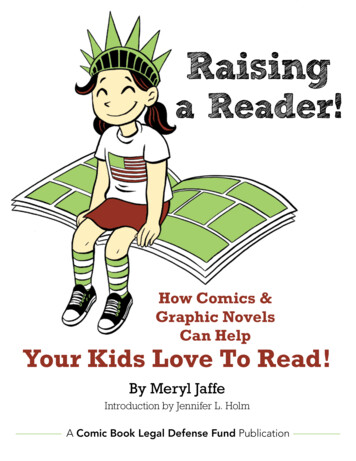
Transcription
Raisinga Reader!How Comics &Graphic NovelsCan HelpYour Kids Love To Read!By Meryl JaffeIntroduction by Jennifer L. HolmA Comic Book Legal Defense Fund Publication
Comics!Not only are they fun, they’re an incredible tool for helping create a genuine love ofreading. While the connection of words and pictures at first seems playful, the skillsreaders develop help provide a practical foundation for other kinds of learning. Fromverbal and visual literacy to critical thinking and memory, comics are a great tool to giveyoung readers a head start.In Raising A Reader, we’ll talk about what comics and graphic novels offeryoung readers, show what goes into reading a comic, and provide somerecommendations for ways to create reading activities for indi viduals and groups. We’ll also give you directions to resources youcan look at next.Here’s to comics, and how they’ll help your kids love to read!— Jennifer L. HolmComic Book Legal Defense FundA non-profit organization protecting the Freedom to Read! We are dedicated to the protection of the First Amendment rights of thecomics art form and its community of retailers,creators, publishers, librarians, and readers.CBLDF provides legal referrals, representation, advice, assistance, and education in thefurtherance of these goals.StaffCharles Brownstein, Executive DirectorAlex Cox, Deputy DirectorKristen Cattell, Office ManagerRobert Corn-Revere, Legal CounselBetsy Gomez, Web EditorBoard of DirectorsLarry Marder, PresidentMilton Griepp, Vice PresidentJeff Abraham, TreasurerDale Cendali, SecretaryJoe FerraraSteve GeppiJennifer HolmPaul LevitzChris PowellCreditsAdvisory BoardNeil Gaiman & Denis Kitchen,Co-ChairsSusan AlstonMatt GroeningChip KiddJim LeeFrenchy LunningFrank MillerLouise NemschoffMike RichardsonDavid Herman, DesignerJennifer and Matt Holm,Raina Telgemeier, ArtistsCorporate MembersWHITEPublication 2013 Comic Book Legal Defense Fund and respective authors.Made possible with the generous support of the Gaiman Foundation.
What Graphic Novels Offer KidsVisit a visual wonderland.Imagine a book with scenes of vivid colors or inblack and white images, whose textures you canfeel escorting you through a story, a life, a world, asshort bursts of text and windowed panels and paneslead you through that realm. This is the graphicnovel reading experience awaiting you and yourkids. It’s inviting, exciting, and always engaging.Graphic Novels provideexciting reading experiences forall kinds of readers.Graphic novels’ short bursts of text (often infun fonts) and vivid images are accessible to allkinds of readers and language learners.For weak language learners and readers,graphic novels’ concise text paired with detailedimages help readers decode and comprehendthe text. Reading is less daunting (with less textto decode), with concise verbiage that highlightseffective language usage and vocabulary, and theimages invite and engage readers.For skilled readers, graphic novels offer a differenttype of reading experience while modeling conciselanguage usage. Because the text has to be succinct,graphic novels model how to efficiently communicatestories, lines, and ideas in short, pithy text.Graphic Novels by their very naturedraw the reader into the story.With graphic novels, readers actively construct thestory as they travel across and down the page frompanel to panel, processing the text and images.Furthermore, the vivid images transport readers,making them feel like they’re there in the middleof the action. This creative and interactive processmakes reading engaging and often more fun.The quality, quantity, anddiversity of kids’ graphic novelsis simply AWESOME.With the explosion of technology, communica tion, and graphic arts, graphic novel illustrations,formats, and story-telling are diverse — appeal ing to all types of readers. Outstanding children’sand young adult graphic novels can be found inan array of genres such as fantasy, science fiction,romance, fiction, biography, and classics. Further more, there has been a dazzling burst of nonfictiongraphic novels, making them extraordinary re sources for learning about science, famous people,places, and events in and out of classrooms. Thesebooks offer a feast for the eyes and mind and areworth a closer look.Graphic novels and suggested graphic novelreading lists for kids of various ages and grades canbe found in local bookstores, comic book shops,libraries, and online. Please visit CBLDF’s monthlycolumn, “Using Graphic Novels in Education,” forsuggestions.However, if you can’t wait for our column, andyour favorite librarian is out with the flu, here are afew resources to help:BooklistVoice of Youth AdvocatesChildren’s Graphic NovelCore Collection (ALSC)Good Comics for Kids @School Library JournalYALSA Great Graphic Novelsfor Teens ListNo Flying No TightsThe Graphic ClassroomKirkus ReviewsGraphic Novel ReporterLibrary JournalDiamond Comics BookshelfLibrary Media ConnectionManga BookshelfSchool Library Journal
Graphic Novels 101:When learning to read graphic novels, you haveto be willing to slow down. Realize that this is a total ly different reading experience. Realize that you willbe reading the text and art, all while incorporatingthe incoming information as you build the story.Here are the basics:In graphic novels, the story is broken downand presented in sequential time frames calledpanels 1. Each panel contains text and/or im ages bound within a specific shape — usually arectangle or box. The panel shape, text,font, color, and shading ALL interact totell the story.The panel border 2 that sur rounds the panel can be as infor mative as the panel itself. Panelborders help your eye and mind define and focuson each story segment. For example:a. D ream sequences are often presented in panelswhose boarders consist of dotted or wavy lines.b. Panels conveying tremendous force or energymay have their panel borders interrupted asobjects, arms, or feet protrude to show force ormovement.c. Sometimes conversation panels are embeddedin larger panels to show what is going on bothwithin an intimate conversation while among alarger whole.The arrangement of the panels 3 on thepage also helps tell the story. Typically, panels arearranged (and read) in sequence from left to rightand from the top to the bottom of the page.In the case of Japanese graphic novels, ormanga, panels are arranged from right to left andtop to bottom, and this reading order is sometimespreserved in the English language presentation.There are times however, when the panel ar rangement may be more novel. For example:a. A small panel may be embedded in a muchlarger panel to help relate background infor mation along with important information theauthors want you to focus upon.b. Sometimes the panels are arranged left to rightfrom the top to the bottom across a two-pagespread instead of one page. This is usually donewhen there are many important sequences (es sential to each other) that can’t be broken upwith the turn of a page.c. T here are also times when the panels are ar ranged in different configurations — a circle forexample — adding details to the story (in thecase of a circular arrangement this may be doneto show the continuity of the interactions).Authors know that if the panel arrangementis too unusual, and the readers’ attention is notclearly drawn to the right sequence, it slows thereading (and comprehension) down. Therefore,creators are thoughtful when designing theirpages and panel arrangements, carefully guidingtheir readers’ eyes and attention.Panels are separated by spaces calledgutters 4. The gutters provide pauses for read ers to integrate information from the panel justread. Also, even though the panels are sequen tially arranged, there are often jumps in time(from nanoseconds, minutes, hours, days, etc.)or jumps between characters, scenes, actions,and/or events. As a result, the gutters allow thereader to pause and integrate what is, and is not,presented by the authors and illustrators.Balloons 5 are typically found inside panelsand contain the story’s succinct text. The balloonsCreators are thoughtful when designing theirpages and panel arrangements, carefullyguiding their readers’ eyes and attention.
Learning How to Navigate31245may contain thoughts, dialogue, and/or soundeffects — each frequently relayed in different bal loon formats. Below is a list of six different typesof balloons (from Using Content-Area GraphicTexts for Learning, Jaffe & Monnin, 2012): Staging balloons inform the readers and set thestage for changes in the plot, character perspec tives, conflict and/or setting. These are often setin rectangular boxes, often using a font differentfrom that used for dialogue. Story balloons tell the story and move it along. Thought balloons relate a character’s thoughts,emotions, and motives. These are typically drawnwith wavy lines or have bubbles connecting thecharacter to the thought. D ialogue balloons contain text that thecharacters say aloud. Sound-effect balloonsI am notconvey a sense or sounda blob!and often contain large,I’m aninteresting fonts.amoeba! B alloon-less balloonsare panels that contain textrelaying some thought, dia logue, or direction not placedin a balloon.
Creating Reading DialoguesWhile the graphic novel reading experience isdifferent from the traditional prose novel experi ence, graphic novels can be read anywhere and inthe same forums. Here’s a more detailed look:Graphic novels forsolo story exploration:This really needs no explanation, but next timeyou’re in a book store or library, look around —you’ll probably notice some lucky kid engrossedin a graphic novel. And, if you’re lucky enoughfor it to be your kid, our bet is that s/he won’twant to leave before finishing or taking it home.Graphic novels in read-alouds:Graphic novels are wonderful read-alouds (to oneor many kids), as they invite kids to watch and listenas the story unfolds. There are a number of waysyou can use graphic novels in read-alouds: Read it aloud much like a prose text. As you readeach panel you point to it, allowing the audienceto follow along. You may want to change yourvoice for the different characters, and lower yourvoice when there is narration or no dialogue.When reading the panels, stop to “take in” and“read” the graphic images as well, comment ing on the details that are there to enrich thedialogue and relateemotions, underlyingimpulses, and addi tional story line. If your child/studentcan read, you maywant to read this as aplay, assigning differ ent roles to differentkids and using theillustrations to helpwith stage directions.Graphic novelsmake greatbook clubselections:Graphic novels havemore dimensions fordiscussion. In additionto the storyline, plot,and characters, groupscan discuss: How the art (illustra tion, page design,and/or word fonts)help tell the storywhile relaying emo tions and characters’underlying motives How the panel place ments help tell thestory How the use or omis sion of color affectedthe story
with Graphic Novels How the artwork (style, color, fonts,panel sizes, and shapes) often changeswith the story line (for example dreamscenes are often shown in panels withwavy lines instead of the traditionalsolid lines); How the text and images work togetherto guide the reader through the story. Why telling this story in sequential artform may or may not have been the mosteffective way of relaying it.Graphic novels as multipleliteracy dialogues:Pairing graphic and prose novels togethercan expand literary and communicationskills. Reading these dissimilar formatson related topics helps kids discover howprose and graphic novels can tell the samestory differently while evaluating the prosand cons of each medium.For example, Marvel has a wonderfulOz series that parallels Frank Baum’s TheWonderful Wizard of Oz. Or you can takea graphic novel like Laika by Nick Abadzis(First Second Books) about how the Rus sians race to send the first sentient being(a dog) into space, and pair it with HomerHickem’s October Sky.For more pairing and multiple literacyideas please check out these resources: Using Content–Area Graphic Texts forLearning (Jaffe & Monnin, 2012) — a guide formiddle school students Teaching Graphic Novels: Practical Strategies forthe Secondary ELA Classrooms (Monnin, 2009) The Graphic Novel Classroom: POWerful Teaching and Learning with Images (Bakis, 2011) — alsofor high school classrooms Teaching Early Reader Comics and GraphicNovels (Monnin, 2011) Teaching Visual Literacy: Using Comic Books,Graphic Novels, Anime, Cartoons, and more toDevelop Comprehension (Frey and Fisher, 2008) B uilding Literacy Connections with Graphic Novels: Page by Page, Panel by Panel (Carter, 2007) G raphic Novel Reporter has teacher links andsuggestions Readwritethink.org -plans/gaining-back ground-graphic-novel-1063.html) Check CBLDF.org for our “Using Graphic Novelsin Education” column for monthly suggestions.Graphic novels have more dimensions fordiscussion than storyline, plot, and characters.
Graphic Novels and Learning:Graphic novels are entering 21st century class rooms on all levels, for multiple goals and reasons.Here are a few of them:Graphic novels empower21st century learners.Students are engaged in a verbal/visual commu nication explosion (infographics; icons on phones,computers and billboards; non-verbal image-driv en directions; blogs, texting, and emails). Graphicnovels clearly reflect this change. Graphic novels,like infographics, texting, and emails, presentessential ideas, dialogue and emotions throughconcise text and images. They also offer enticingmultimedia reading experiences to all kinds ofreaders and learners.Graphic novels attractall kinds of readers.From strong language learners to weak or secondlanguage learners, graphic novels attract readerswith incredible art and text that unfolds in a multi media story experience.Graphic novels easily answerNational Common Core StateStandard mandates.Most states have mandated Common Core StateStandards (taking effect in 2014) with the goal toteach students to think more critically about whatthey’re reading, writing, and speaking in languagearts, science, math, and history/social studies.Common Core mandates that students employ,evaluate, and compare multiple literacies (with astrong emphasis on non-fiction) utilizing contentfound in multiple formats and giving reliablysourced evidence to support their opinions. Fur thermore, as noted in Appendix B of the CommonCore Standards, “visual elements are particularlyimportant in texts for the youngest students andin many informational texts for readers of all ages.”As graphic novels incorporate both verbal andvisual literacies and as there are many outstandingnon-fiction and historical fiction graphic novels,they are an excellent classroom resource.Graphic novels reinforcecritical thinking ina number of ways.
An Awesome Combination for21st Century LearnersHere are just a few ways graphic novelshelp meet the new state standards: They typically use advanced and con cise vocabulary to tell a story while theimages help define and reinforce words,with the word-image pairing provid ing additional memory associations forconcepts. Reading paired prose and graphicnovel texts better reinforces memoryof content material, as readers createboth verbal and visual memory pathsand associations. Panel displays and concise text helpreaders clearly distinguish betweenmain ideas and details. C omparing prose and graphic novelsprovides insight into two very differentliterary formats, leading to discussionson use of dialogue vs. image vs. sen tence/paragraph chapter development.Thus, readers gain a deeper understand ing and appreciation of various literarystyles, formats, and text structures. As the themes, ideas, characters, andevents are developed in a visually se quential manner in graphic novels, it iseasy to chart their development. Graphic novels provide an outstandingmeans of studying metaphor, as imagesare often used to develop and rein force them.Graphic novels foster andstrengthen multiple learningskills essential for successin and out of the classroom.Attention and attention to detail: Readingand integrating text and illustrations in graphicnovels help students slow down as they read andfacilitate observation of and focus on details.The short bursts of text empower students whohave weak attention skills, helping them focus onlanguage and the unfolding plot while the en gaging art holds their attention and draws theminto the details.Memory: Graphic novels pair visual and verbalstorylines, creating additional memory pathwaysand associations. Research shows that our brainprocesses and stores visual information faster andmore efficiently than it does verbal information. Asa result, incorporating graphic novels into homeand school libraries and pairing them with tradi tional prose texts is an excellent means of promot ing verbal skills and memory.continued on next page
Graphic Novels and Learningcontinued from previous pageSequencing skills: Graphic novel panels andtheir sequential arrangement of page and storyvisually and verbally break the story into easilyrecognizable parts. As a result, readers automati cally focus on its sequence, reinforcing conceptsof beginning, middle, and end. Furthermore,with graphic novels, students can easily chart de velopment of story, character, plot, and themesover time.Language and language usage: Graphicnovels appeal to all language learners and read ers. The concise text highlights word usage andvocabulary. The illustrations help define andreinforce vocabulary. Graphic novel selectionsin classrooms empower and engage all types oflearners and readers, and increasing numbers ofsecond language learners havecommented on how read ing graphic novels helpedexpand their vocabulary andgrammar skills.Critical thinking: Graphic novelsreinforce critical thinking in anumber of ways. Abstract con cepts such as inference, meta phor, and social context are oftendifficult concepts for kids to comprehend. They areusually taught through classroom discussions, whichpose a distinct challenge for visual learners, forstudents with weak language skills, or for concretelearners with weak higher-order cognitive skills.Graphic novels can help by: Verbal and visual cues ingraphic novels aid comprehen sion and inference. Visual details help explain andreinforce content and abstractmessages. Visual and verbal cues em power readers to compare andcontrast how vital informationis presentenced. Metaphors permeate graphicnovels, and the visual andverbal pairing makes themmore obvious, more concrete,easier to understand, and morerelatable. Sequential presentation of textand images provides naturalopportunities for scaffoldingand comprehension. Graphic novels’ gutters offernatural breaks in which read ers can pause to evaluate whatthey just read, making surethey comprehend events andcharacter motives. Information (and story) gapsbetween the panels require ac tive problem solving as readersextrapolate what is missing. Short bits of text make it easierfor readers to recognize themain ideas.
Protecting Kids’ Right To Read!There are graphic novels for every reader, butnot every graphic novel is right for all readers.Much like prose, movies, and TV, comics are ahuge medium encompassing a wide variety of sto ries. Just like other entertainment media, parentsshould be involved in deciding what comics areright for their kids to read.Comic Book Legal Defense Fund works to helpparents in this area in a variety of ways. We pub lish informational tools like this one. We also offerregular features on CBLDF.org, such as our “UsingGraphic Novels in Education” column.One of our signature efforts is our activity asa sponsoring partner of the Kids’ Right to ReadProject, a coalition of organizations that monitorsSupportand responds to challenges tobooks in schools and libraries. Aspart of KRRP, we provide proac tive substantive assistance to helpkeep comics in circulation whenthey are challenged.CBLDF believes that parentshave a right to choose whatcomics are appropriate for theirchildren to read, and that all par ents should be afforded that samefreedom of choice.To learn more about theCBLDF’s efforts to protect the Kids’Right to Read, please visit www.cbldf.org, or .CBLDF’s important work is only possible because ofComic BookLegal Defense Fund!the support of individuals like you. Show your supportfor our work protecting the freedom to read by makinga tax deductible membership contribution today! Hereare some items you can get to show your support!Get a ‘Raising A Reader’ Kit!Membershipq 40 donationIncludes:4 “L’il Liberty” Button by Raina Telgemeier4 “Proud to Raise A Reader” Button4 CBLDF bumper sticker4 “L’il Liberty” Print by Raina Telgemeier4 Signed Jennifer L. Holm book!q 25 Basic Membership (includes member card)q 50 Supporter (includes button set, sticker set, member card)q 100 Advocate (includes t-shirt, button set, sticker set,member card) q 250 Defender (All of the above, plus hooded sweatshirt orlimited print) q 500 Protector (All of the above, with sweatshirt and polo shirt)q 1000 Champion (All of the above, plus personalized certificateof thanks from Brian K. Vaughan or Neil Gaiman)NameAddressCityStateZipEmailq Credit Card No.Card TypeExp.CVSignatureq Please make checks payable to CBLDF.q Or visit us at CBLDF.org/contribute.Thank you for your support! The CBLDF is recognized by the IRS as a not-for-profit 501(c)3 institution, and donations are taxdeductible in the year in which they are given. Please contact us for information on deductible amounts for CBLDF premiums, and consultyour tax advisor as to the extent to which your donation is tax-deductible.
About the AuthorsMeryl Jaffe, PhD, teaches visual literacy and criti cal reading at Johns Hopkins University Center forTalented Youth OnLine Division and co-author ofUsing Content-Area Graphic Texts for Learning. Sheused to encourage the “classics” to the exclusionof comics, but with her kids’ intervention, Merylhas become an avid graphic novel fan. She nowincorporates them in her work, believing that theeducational process must reflect the imaginationand intellectual flexibility it hopes to nurture. Merylhopes to empower educators and encourage anongoing dialogue promoting kids’ right to readwhile utilizing the rich educational opportunitiesgraphic novels have to offer. More information canbe found at www.departingthetext.blogspot.com.Jennifer L. Holm is a New York Times bestsellingchildren’s author and the recipient of three New bery Honors for her novels Our Only May Amelia,Penny from Heaven, and Turtle in Paradise. Jennifercollaborates with her brother, Matthew Holm, ontwo graphic novel series — the popular Babymouseseries and the bestselling Squish series. She is alsothe author of several other highly praised books,including the Boston Jane trilogy and Middle SchoolIs Worse Than Meatloaf.Comic Book Legal Defense Fund255 West 36th Street, Suite 501New York, NY 10018www.cbldf.orginfo@cbldf.org
Here’s to comics, and how they’ll help your kids love to read! — Jennifer L. Holm Comics! A non-profit organization protecting the Free-dom to Read! We are dedicated to the pro-tection of the First Amendment rights of the comics art form and its community of



